#daniel farson
Explore tagged Tumblr posts
Text

Salvador Dali | Daniel Farson | Lost Glasow
46 notes
·
View notes
Text

Lucian Freud, Dublin, August 1952 .. photograph by Daniel Farson ..
68 notes
·
View notes
Text

Daniel Farson (c.1958) from the BBC television programme People In Trouble. Farson was a British writer and broadcaster. A prolific biographer and auto-biographer, mainly chronicling the bohemian life of Soho. He was also a photographer with several of his prints in the National Portrait Gallery.
11 notes
·
View notes
Text

Frank Auerbach at the LCC Open Air Exhibition, July 1948
Embankment Gardens, London
Photo: C. Daniel Farson
25 notes
·
View notes
Text

Richard Burton photographed by Daniel Farson, 1953
#elizabeth taylor#richard burton#old hollywood#burton and taylor#black and white#vintage#1960's#love#photography#60's#old hollywod glamour#smoking
107 notes
·
View notes
Text
interview with the vampire art history lesson part 2:
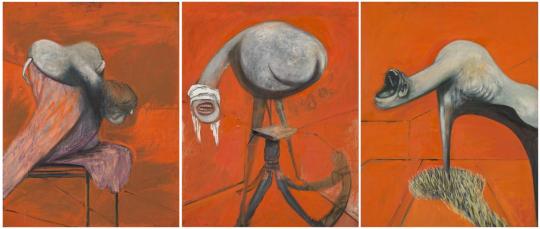
Three Studies for Figures at the Base of a Crucifixion, Francis Bacon, c. 1944. Held at the Tate Britain in London. Here is its catalog listing.
So! This is the painting that has been on the wall of Louis and Armand's apartment, and that Season 2 makes a point to emphasize that they're selling. Full disclosure, modern British art history is not my forte, but I have covered this in a British art history survey class, and this is arguably one of Bacon's most famous works, so there's a lot of literature you can find on this. Let's discuss!!!
Now, one claim that you can try to make here about the relationship of this painting with Armand specifically is that Armand is now connected to two 'Christian' artworks (see my post on The Adoration of the Shepherds with a Donor here): one that marks the beginning of Christ's (semi)mortal life, and one that marks the end of it, which is definitely interesting, but the thing is with this Three Studies piece is that Francis Bacon put a lot of emphasis on the fact that this is a crucifixion, not the Crucifixion. Francis Bacon was an atheist, however, a lot of his work does revolve around either critiquing or dealing with Christianity (this is not his only work to reference/allude to or show the Crucifixion, as well as his other very famous work, Study after Velázquez's Portrait of Pope Innocent X). It was a very nuanced, complex topic for him that is way beyond the scope of this post.
Interestingly, though, Bacon has made a point to say that "faith is a fantasy" [1]----which is definitely something interesting in relation to Armand...
What Three Studies is definitely associated with, though, is World War II and Greek tragedy.
The catalog entry from the Tate spends a while discussing the process of this painting, and how Bacon may have drawn from his various experiences during World War II (he was in the ARP during the London Blitz), as well as other works made around this time (namely, Figure Getting Out of a Car and Man in a Cap) referencing various Nazi imagery that Bacon had seen impacting his process for creating this triptych. Various scholars have cited Bacon as interested in the dynamics of power and violence, and the imagery of the triptych can be interpreted as either the perpetrator and/or the victim [2]. Bacon has also confirmed that this painting references the Eumenides (the Furies who are responsible for enacting revenge in Greek mythology) [3 + 4].
Now that we've covered the very basics of this work, let's discuss how this might relate to Louis and Armand. This work being present in the show has raised some interesting points for me, and some questions:
The show makes a point of emphasizing that they're selling this work. Since this work is so closely related to World War II, and Louis and Armand are currently trying to relay their experiences during World War II, is the selling of it symbolic of either 1) 'selling' their story to Daniel or 2) finally closing out that chapter in their lives?
It is interesting that in their apartment, there is only modern and post-modern artwork and architecture. I wonder how deeply this ties to Armand's trauma, since he himself was modeled (whitewashed as he was) in Late Renaissance/Mannerism artwork from the 1500s. How much of that experience drives his taste in art?
Bacon's juxtaposition and struggle with violence, power, and the dynamic of the perpetrator/victim is extremely interesting... the thoughts are still cooking about this one.
What do u guys think.... i've been microwaving this in my head all day along with the other painting!
Works Cited + Referenced:
[1] D. Farson, The Gilded Gutter Life of Francis Bacon, London, 1994, p. 134. [Taken from this JSTOR article, further cited below] [2] Referencing the catalogue here, which cites: Ziva Amishai-Maissels, Depiction and Interpretation: The Influence of the Holocaust on the Visual Arts, Oxford, New York, Seoul and Tokyo 1993, pp.189-90, 225-6, 354. [3] M[ichael] C[ompton], letter to Francis Bacon, 6 Jan. 1959, Tate Gallery cataloguing files. [4] Francis Bacon, letter to Tate Gallery, [9 Jan. 1959], Tate Gallery cataloguing files. [5] Arya, Rina. “The Primal Cry of Horror: The A-Theology of Francis Bacon.” Artibus et Historiae 32, no. 63 (2011): 275–83. http://www.jstor.org/stable/41479747.
45 notes
·
View notes
Text

Lucian Freud and Brendan Behan (1952)
Photo: Daniel Farson
#menswear#men's style#men's fashion#style#fashion#lucian freud#street style#street fashion#vintage menswear#vintage fashion#vintage style
17 notes
·
View notes
Text
Pleasant Home, Oak Park IL
Pleasant Home (Farson-Mills House), 1897, 217 Home Avenue, Oak Park, IL 60302
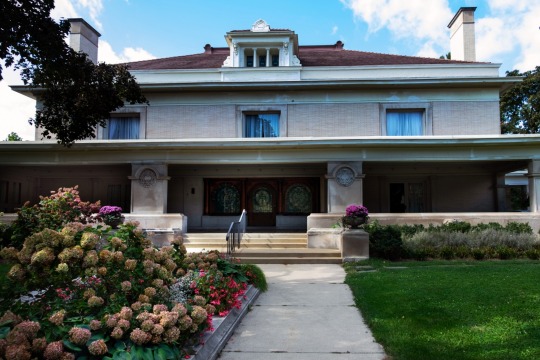
Pleasant Home
George W. Maher designed this 30-room mansion for millionaire banker John W. Farson of Oak Park. Farson purchased the lot at the corner of Pleasant St. and Home Ave. in 1892 for $20,000, the largest price ever paid for a residential lot in Oak Park. Over the following years he acquired land to the south and west for a large garden.
Herbert S. Mills, the second owner of Pleasant Home, made his fortune in the amusement business. The Mills family sold the house in 1939 to the Park District of Oak Park, the grounds being designated as Mills Park in their honor.
The home today is operated as a historic house museum, an events venue, and serves as the headquarters for The Pleasant Home Foundation.
The house is listed on the National Register of Historic Places.
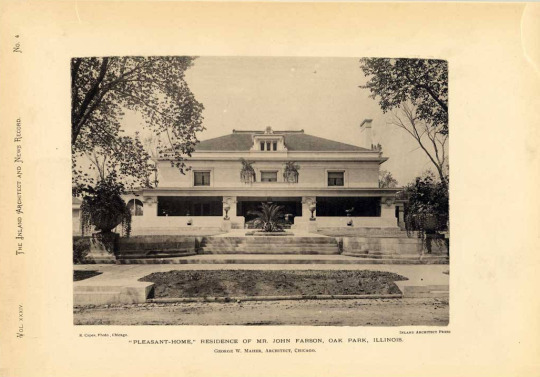
Illustration of Pleasant Home from The Inland Architect and News Record
Considered one of the earliest examples of prairie school architecture, Pleasant Home is often viewed as the finest surviving example of Maher's residential work. The house was completed three years after Frank Lloyd Wright's Winslow House in River Forest, an early expression of Wright's emerging design principles, later to be known as the prairie style.
The Prairie School developed in sympathy with the ideals and design aesthetics of the Arts and Crafts movement of 19th century England by John Ruskin, William Morris, and others. It is also seen as a successor to the Chicago School of architecture associated with architects William Le Baron Jenney, H.H. Richardson, Daniel H. Burnham, John Wellborn Root, Dankmar Adler, and Louis Sullivan.
The Prairie School attempted to develop an indigenous North American style of architecture, without the design elements and aesthetic vocabulary of earlier styles of European-influenced architecture such as the Queen Anne and Gothic Revival styles.
The smooth surfaces of Roman brick, the low-pitched, hipped roof and the broad entrance porch of the Parson House are characteristic features of Maher's work that link him to the early modern designs of his Prairie School contemporaries. In the Parson House Maher also introduced his personal design philosophy, which he called motif rhythm theory, to unify the decorative details of the house and its furnishings. The house retains its historic integrity in terms of materials, design and setting. Virtually all of the original decoration specified by George Maher is preserved and the lavish decorative treatment is everywhere apparent on the interior.
Kathleen Cummings, National Historic Landmark Nomination, 1996
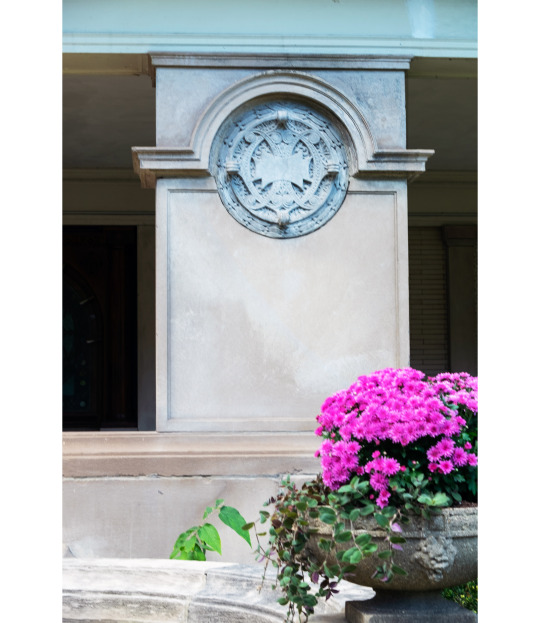
Detail of front porch support column
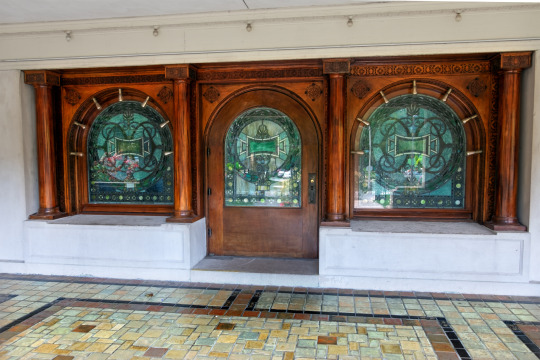
Stained glass entrance and flanking windows
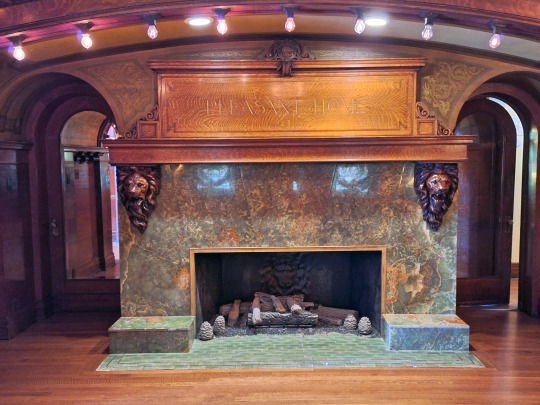
Entrance hall fireplace beneath Pleasant Home panel
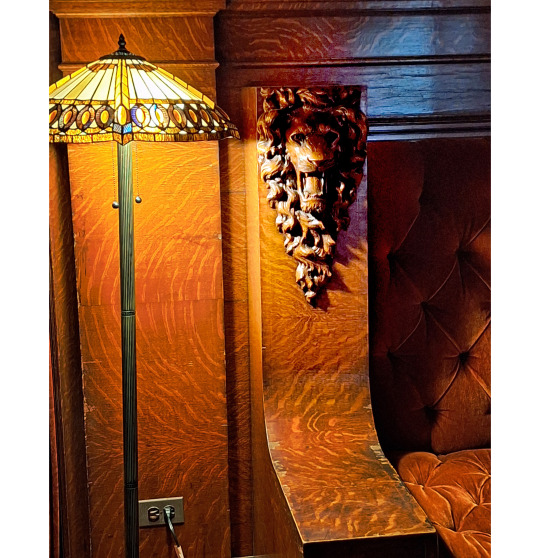
Detail of lion head carving, repeated throughout the house, on entrance hall built-in bench
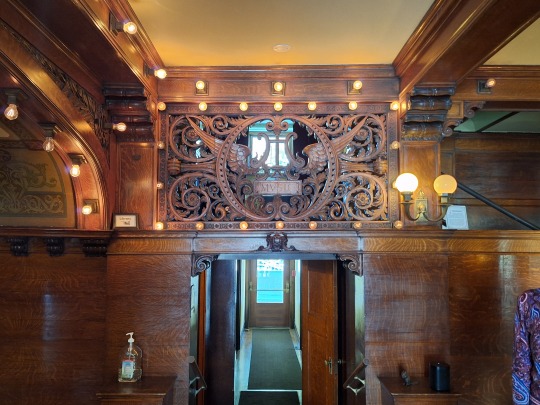
Carved screen in entry hall in front of the music room on the mezzanine
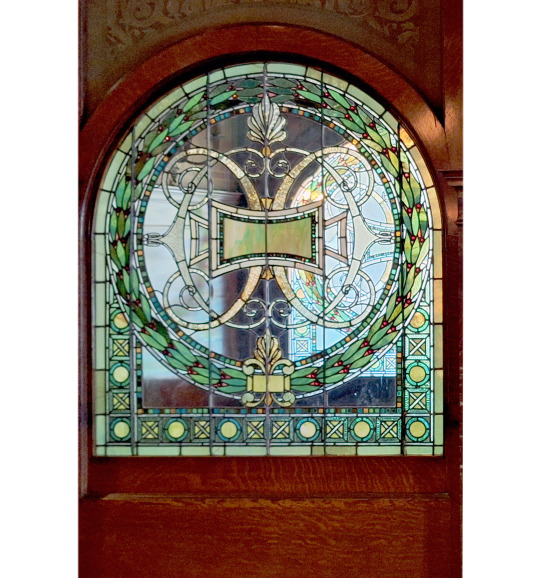
Stained glass entrance window

Reception room
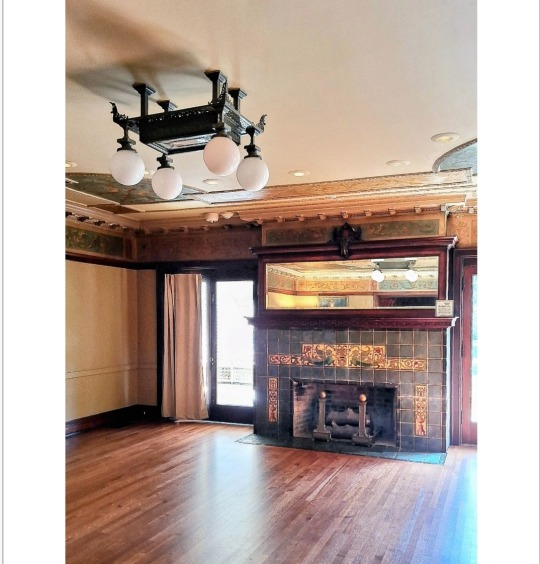
Living room or sitting room

Dining room ceiling fixture

Dining room
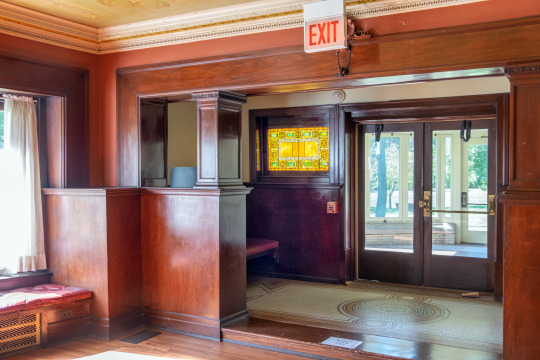
Dining room corner, leading to summer dining room
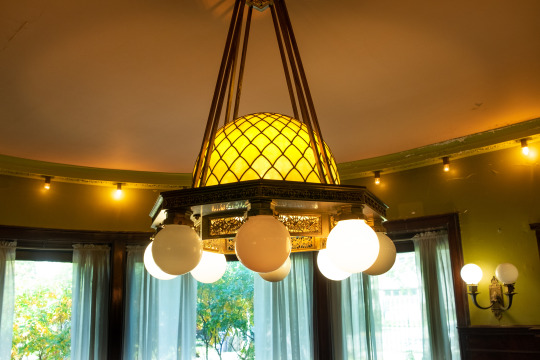
Domed light fixture in the library
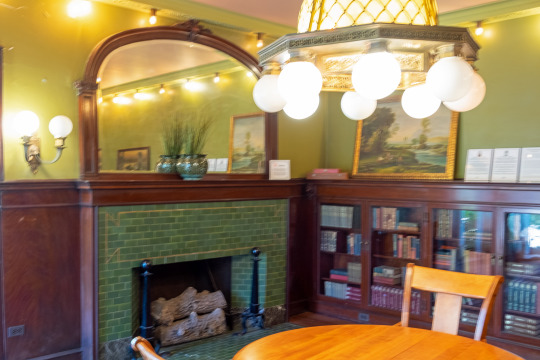
Library
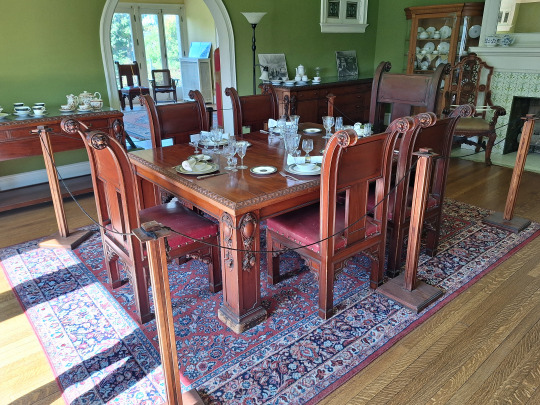
Original Maher-designed dining table and chairs, now displayed on the second floor
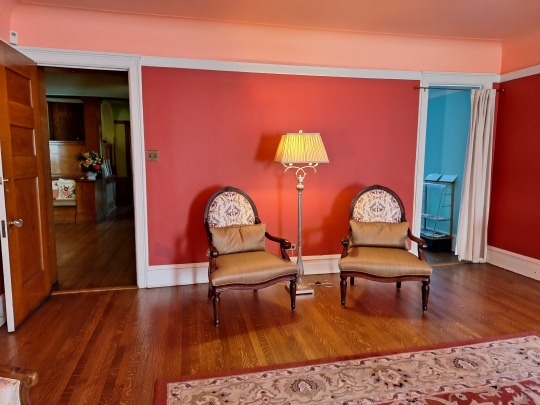
The stunning original wall colors are seen in the above two photos of second-floor bedrooms
Vintage views of Pleasant Home, from the Ryerson and Burnham Libraries, Art Institute of Chicago:
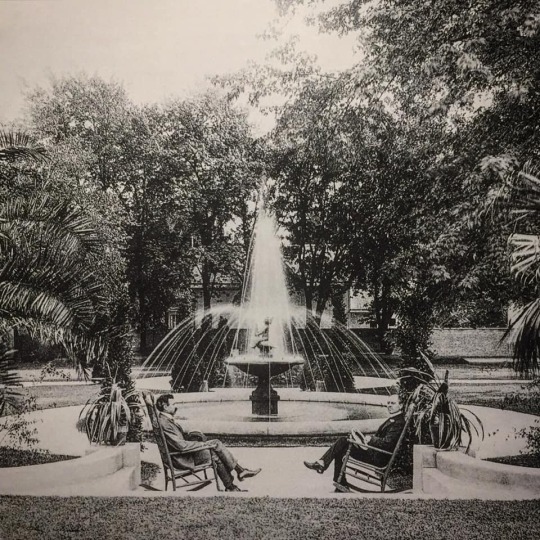
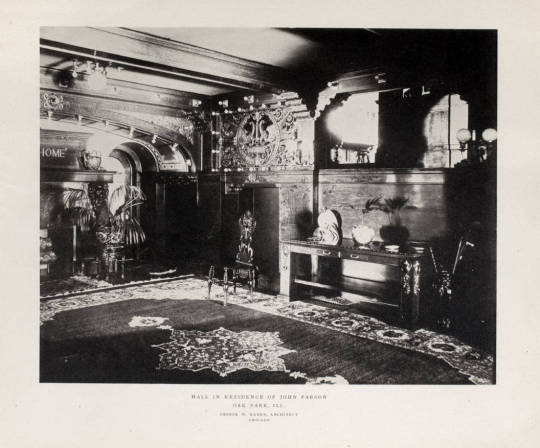
Left: George W. Maher and John W. Farson in the garden of Pleasant Home
Right: Entrance hall


Left: dining room Right: sitting room
The Ryerson and Burnham Libraries, Art Institute of Chicago, house a copy of the 1902 publication "Farson, John, Residence; Farson-Mills Pleasant Home." The publication contains many views of the house, exterior and interior.
Collection Call Number FF Special NA7239.M34 A65 1902.
Access the digitized copy at this link:
#Farson#house#Oak Park#Illinois#Pleasant Home#George W. Maher#Maher#architecture#chicago#photography#Prairie Style#residential
1 note
·
View note
Text

©Daniel Farson
Deakin was stablished in his questionable pomp: a slightly foxed member of a pickled court ... still wounded, nursing bruised ribs, solitary in the mob, going with the flow. Willingly cursed. Blessed with infamy. Carrying the camera like a security-tagged bracelet. See it and know where Deakin is hiding.
-Iain Sinclair
0 notes
Text

Bonjour, bonne journée ☕ 🌞
Bain de soleil à Hyde Park 1952 Londres
Photo de Daniel Farson / Hulton Archive
#photooftheday#photography#black and white#vintage#daniel farson#canicule#hyde park#londres#angleterre#bonjour#bonnejournée#fidjie fidjie
42 notes
·
View notes
Photo

Alan Lee
#horror#reading#book#beaver#mummy#werewolf#vampire#monster#frankenskies#death#grim reaper#cover#beaver book of horror#daniel farson
2 notes
·
View notes
Text

Frank Auerbach (1948) photographed by Daniel Farson.
34 notes
·
View notes
Photo

Richard Burton, by Daniel Farson, 1953
14 notes
·
View notes
Photo

Spanish surrealist painter Salvador Dalí in his studio in Port Lligat painting ‘Christ of St John on the Cross’, November 1951
@ Daniel Farson
5 notes
·
View notes
Photo

Cyril Connolly and Lady Caroline Blackwood, circa 1953
Photograph: by Daniel Farson - National Portrait Gallery, London
5 notes
·
View notes
Photo

Fashion model Pat Goddard photographed by photographer Daniel Farson Aug. 1952, UK
45 notes
·
View notes